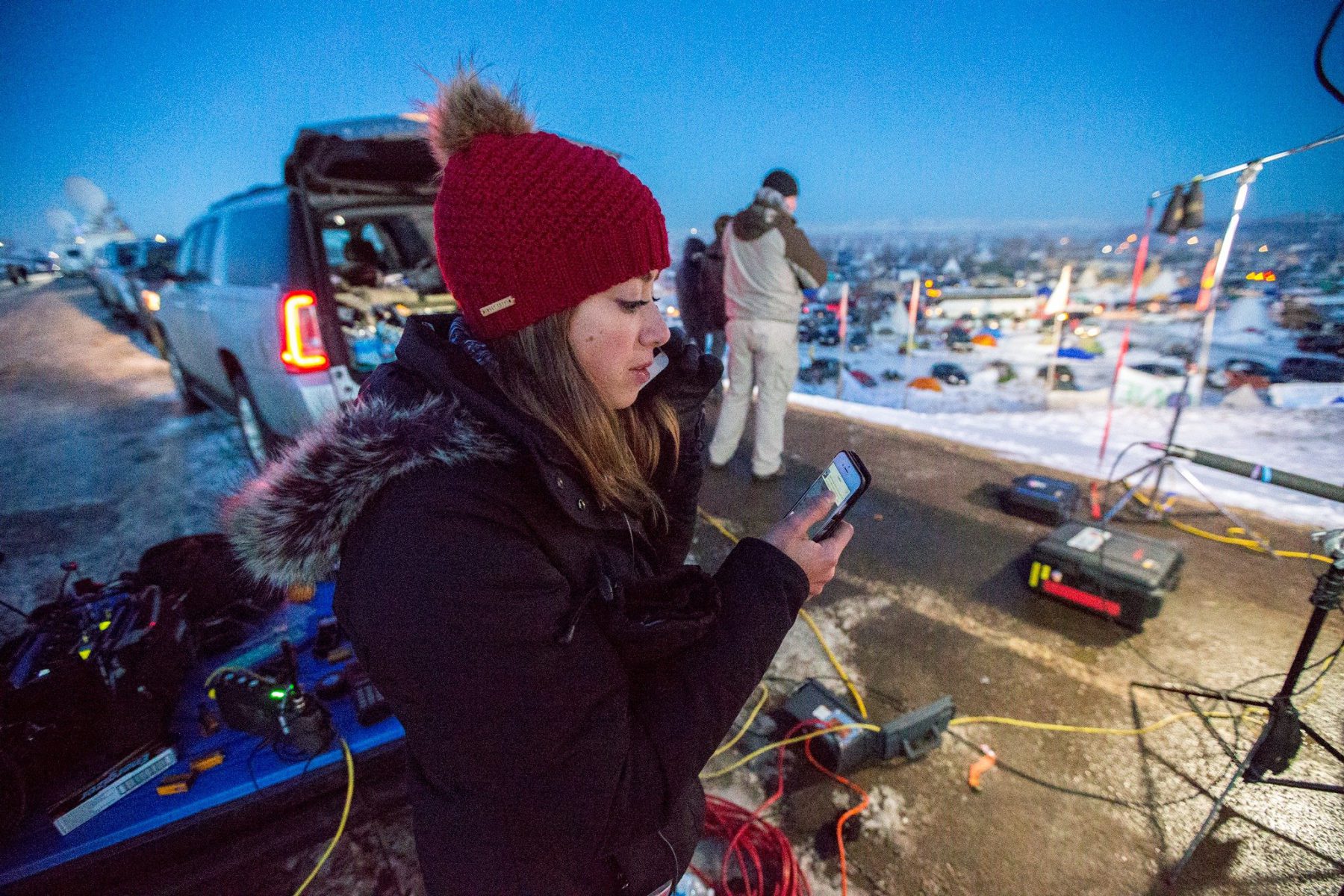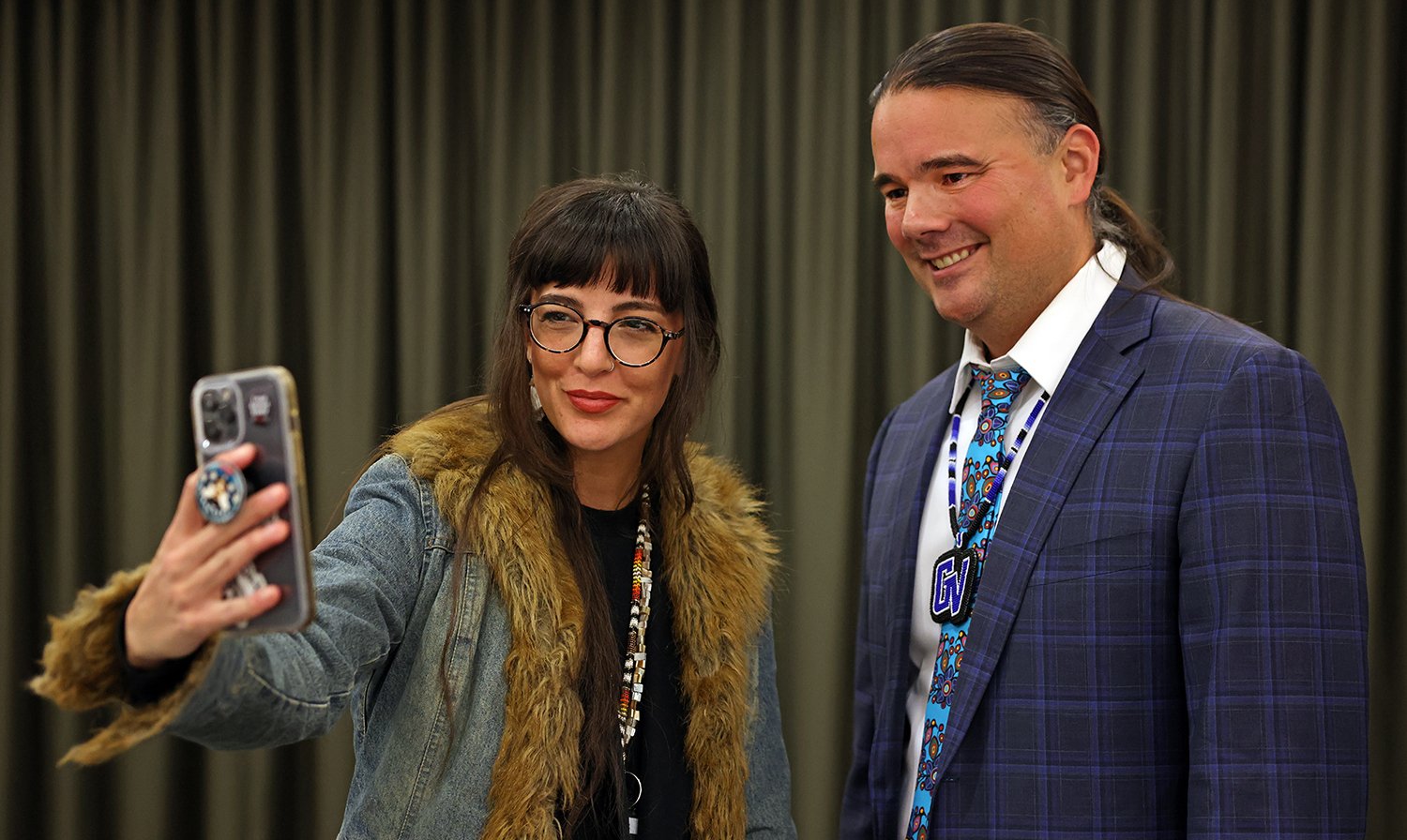
Like many Indigenous reporters, Sierra Clark had to chart her own path.
At the height of the pandemic, she left her career in science for journalism, wanting to report on the Indigenous issues she couldn’t find in her local news outlets. She was a founding member of the Mishigamiing Journalism Project, which trains and puts Indigenous reporters in Michigan newsrooms, and got her first year as a reporter funded through grants and other fundraising efforts. Last year, she was hired full-time at the Traverse City Record-Eagle through the nonprofit Report for America, making her the first journalist to solely cover Indigenous affairs in northern Michigan, a state that’s home to over 100,000 Indigenous people.
“You can’t have something be completely accurate if you don’t have a relationship with the community, if you don’t spend time building relationships with that community,” said Clark, an Odawa Anishinaabe kwe from the Kitchiwikwedongsing area of Michigan.
The Indigenous affairs beat has gained traction in recent years, thanks in part to the perseverance and work of Indigenous reporters like Clark, coupled with newsrooms’ growing interest in reconciling their diversity shortcomings and programs dedicated to covering underrepresented communities. Report for America’s partnership with the Native American Journalists Association, of which Clark is part, is one of the first of its kind: In January 2020, it trained and placed 19 Indigenous affairs reporters in newsrooms across the country, paying a percentage of their salaries for two to three years. A handful of those who have graduated out of the program have been hired full-time at their host newsrooms.
While such infrastructure and external financial support is remarkable, is it sustainable? The goal, it seems, would be for newsrooms to prioritize Indigenous affairs reporting, empower these reporters and recognize the value of this coverage for themselves.
I spoke with four Indigenous reporters who cover Indigenous communities, as well as several newsroom leaders, about what it would take for news managers to continuously invest in Indigenous affairs coverage. Here’s what they said.
Hire Indigenous people in your newsroom
The overall lack of Indigenous affairs reporting in national and local newsrooms is a bit of a Catch-22: An outlet that has rarely covered Indigenous communities usually doesn’t know what kind of Indigenous stories to look for, and it doesn’t know what to look for because it has never prioritized this coverage area.
Everyone I talked to for this story said one way to fix this conundrum is to hire Indigenous journalists. They don’t have to specifically cover Indigenous affairs, and they don’t even have to be reporters — they can be producers, copy editors, sports broadcasters — but their perspective is often missing in newsrooms, an issue that needs to be rectified.
“There’s plenty of stories that I write that other reporters don’t see, just because they don’t understand the cultural implications at play,” said NBC News senior reporter Graham Lee Brewer, a member of the Cherokee Nation. “When you’re just simply existing in those spaces, you can help change conversations and the directions of stories.”
In June, Brewer reported the story of a Lakota teacher fighting to preserve the tribe’s language after a white man tried to sell it back to them. He also reported on a Supreme Court decision that delivered a massive blow to tribal sovereignty — a case that was overshadowed by other SCOTUS decisions this summer — speaking to tribal leaders and Indigenous legal experts, perspectives often missing in stories about Native communities.
Frank Vaisvilas, who traces his roots to the Yaqui of Mexico, said when he was first hired at the Green Bay Press-Gazette as part of the Report for America program, one of his editors told him he wasn’t sure he would be able to find many stories. In his two and a half years there, he has written about such topics as tribes finding economic opportunities through cannabis, Native American chefs, the harvesting of wild rice to protect the environment and schools still using Indigenous-based mascots. His editor was happy to be proven wrong; Vaisvilas now writes a weekly newsletter that’s garnered thousands of subscribers statewide.

NBC reporter and producer Chiara Sottile, of the Karuk tribe, related the power of Indigenous people telling their own stories to the Santa Fe Indian School, which she recently reported on and teaches in three Native American languages. “It’s an act of resistance,” she said because “the counter forces are so strong” against keeping tribal cultures alive. “And empowering Native journalists is another way to fight that tide.”
Take time to build relationships and battle mistrust
Mistrust is another huge roadblock to covering Indigenous communities. Media haven’t historically treated Indigenous people well, with newsrooms either ignoring their existence or parachuting into reservations to cover casinos or what the Indigenous Canadian journalist Duncan McCue called the “W4D”: being a warrior, drumming, dancing, drinking or being dead.
“Challenges are amplified for Indigenous affairs beats because of the history of media harm and lack of coverage,” said Rachel Rohr, vice president of program development at Report for America. Beat building “can take longer, which I think can be challenging for the reporters and the editors. It’s not going to happen overnight.”
Clark said she didn’t trust journalists, and that’s why she became one. Eighteen months into her job at the Record-Eagle, she still spends a lot of time having one-on-one conversations with people in her community. She doesn’t just want to report stories of trauma or tragedy, which is why she started her biweekly column, Anishinaabek Neighbors, featuring Anishinaabek birth workers, nuclear engineers, seed farmers and cab company owners.
Vaisvilas takes a similar approach. When he started at the Press-Gazette, he often published smaller stories about the community to show he can be trusted to get it right. “We have to show people we’re not just here to extract a story from them to make us look good,” he said. “But that we’re here to tell your side of things, we want to give you a voice and help you tell your story better to the world.”
Vaisvilas’s editor, Mark Treinen, said he’s learned through Vaisvilas’s work that it’s important to go slow and listen to communities who have been left out of or burned by the media. “That was the way he built trust and credibility: You tell me something and you think it’s important, and then you see it published,” Trienen said. “It’s affirming.”
Understand that covering Indigenous communities is a matter of accuracy
If you are a news outlet responsible for covering a certain geographical region — whether that’s a county, a state or the entire U.S. — and you are not seeking out sources from and stories about whole populations, many would argue you are not presenting the truth to your readers about what is happening in your community.
“One of the first imperatives, to me, is being accurate about who is in our community,” said Treinen. That includes what they are doing, who’s being left behind and who is affected by decisions made by people in power, he said. “And if you are dedicated to being fully accurate about that, you need to reach out to all the communities within your community. And you need to develop those relationships, those sources, and have your reporting staff make those connections.”

As Clark pointed out, part of that accuracy is not just seeking “doom and gloom” stories, either — it’s seeing people for their whole selves. It’s important that newsrooms be transparent about mistakes and promise to do better — including bringing in Indigenous reporters to cover these communities.
“Journalism inherently is a colonial structure, and I’m not the one that’s going to be able to decolonize that,” Clark said. “But I chose how I can bring in my perspective as an Odawa woman, and it’s really about who I’m serving, and that’s my community.”
Get others on board
While it is imperative to follow the lead of Indigenous journalists who understand the communities they’re covering, getting newsrooms invested in Indigenous affairs cannot just be the project of Indigenous people alone.
Brewer said when he started at NBC News, his editors had no experience covering Indian Country or federal Indian law. But they did their homework, and now his editors will feed him story ideas — sometimes, things he didn’t even know about. “They put in the time and the work,” he said. “They also listened to me and take me seriously.”
News leaders and allies who do value this coverage need to speak up about it, so other newsrooms take note and see the opportunity for growth. “They need to talk more publicly about how it’s been worth it, because it really is an investment,” Rohr said. “Challenge number one might be getting them to do it in the first place. But challenge number two is doing it well.”
When there are Indigenous affairs reporters in newsrooms, colleagues will also start to think about how they can incorporate an Indigenous lens in their own beats, whether it’s the economy, education or health. Vaisvilas has had other reporters approach him about how to best cover the 11 federally recognized tribes in Wisconsin and whether they’re stepping on his beat. “I welcome the help,” he said. He even started a group chat to educate and coordinate Indigenous news reporting across the state.
While the onus to educate colleagues on Native American history and culture can be overwhelming for the sole Indigenous affairs journalist in the newsroom, NBC’s Sottile understands that what she brings to her job is her expertise and lived experience, both of which should be taken seriously.
“Everybody should be thinking about what is the race angle of their story — that’s true,” she said. “But if it’s everybody’s job, then it’s nobody’s job. You need to empower your staff to do that work for you, and support that work.”
Ultimately, newsrooms need to be intentional and follow through on remedying their deficiencies. “If you wanted your newsroom to be diverse,” Brewer said, “it would be.”


